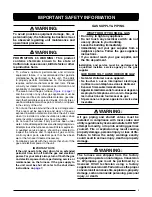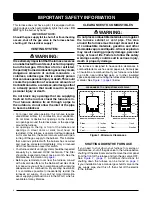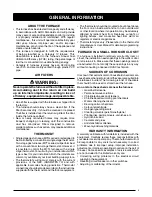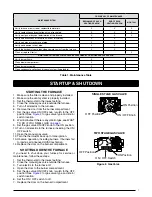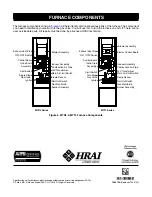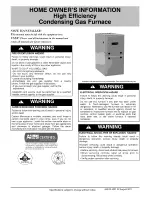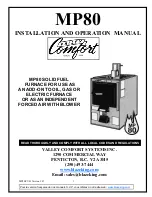
5
ABOuT THe fuRNACe
• This furnace has been tested for capacity and efficiency
in accordance with AHRI Standards and will provide
many years of safe and dependable comfort, providing
it is properly installed and maintained. With regular
maintenance, this unit will operate satisfactorily year
after year. Abuse, improper use, and/or improper
maintenance can shorten the life of the appliance and
create unsafe hazards.
• This furnace is designed to fulfill the requirements
of being classified as a Category IV furnace. This
classification is related to the furnace’s Annual Fuel
Utilization Efficiency (AFUE) rating, the percentage of
fuel that is converted into usable heating energy.
• Category IV furnaces typically have an AFUE rating
over 90% and are mainly vented through plastic PVC
pipe.
AIR fILTeRS
WARNING:
Never operate the furnace without a filter in place.
Accumulating dust in the return air can build
up on internal components, resulting in loss of
efficiency, equipment damage, and possible fire.
• An air filter is supplied with the furnace as shipped from
the factory.
• The furnace should always have a clean filter. If the
filter becomes dirty, it should be cleaned or replaced.
The filter is installed over the return air grille of the door
inside the furnace cabinet.
• New or newly renovated homes may require more
frequent changing or cleaning until the construction
dust has minimized. Filters designed to remove
smaller particles such as pollen, may require additional
maintenance.
THeRMOSTAT
• Single stage gas furnaces (M7RL series) are designed to
be controlled by a conventional single stage thermostat.
Two-stage gas furnaces (M7TL series) will perform best
with a conventional two-stage thermostat. However, it
is possible to control the M7TL furnace with a single
stage thermostat. Consult with your installer about which
type is best for your installation. Both thermostats are
commonly available at your local building supply store.
• The thermostat’s wiring must comply with the current
provisions of the NEC (ANSI/NFPA 70) and with
applicable local codes having jurisdiction. Thermostat
connections should be made according to the instructions
supplied with the thermostat and the indoor equipment.
• The thermostat should be mounted about 5 feet above
the floor on an inside wall and not on an outside wall
or other location where its operation may be adversely
affected by radiant heat from fireplaces, sunlight, or
lighting fixtures, and convective heat from warm air
registers or electrical appliances.
• Thermostat styles vary. Please refer to the thermostat
manufacturer’s User Manual for detailed programming
instructions.
fuRNACe IN A SMALL ROOM OR CLOSeT
If a furnace is installed in relatively small utility room or
closet, the installation needs openings in the walls or door
to let return air in. Make sure that these openings remain
unobstructed. Do not modify these openings in any way
without consulting a licensed HVAC technician.
SOuRCeS Of CORROSION
It is known that certain common household chemicals can
cause heat exchanger corrosion if the vapors are pulled into
the furnace’s burners The following is a list of chemicals
that should not be used or stored near the furnace.
Do not store these chemicals near the furnace:
• Gasoline/Kerosene
• Permanent wave solutions
• Chlorinated waxes and cleaners
• Chlorine based swimming pool chemicals
• Water softening chemicals
• De-icing salts or chemicals
• Carbon tetrachloride
• Halogen type refrigerants
• Cleaning solvents (perchloroethylene)
• Printing inks, paint removers, varnishes, etc.
• Hydrochloric acid
• Cements and glues
• Antistatic fabric softeners
• Masonry acid washing materials
WARRANTY INfORMATION
A warranty certificate with full details is included with the
equipment. Carefully review these responsibilities with
your dealer or service company. The manufacturer will not
be responsible for any costs found necessary to correct
problems due to improper setup, improper installation,
adjustments, improper operating procedure on the part of
the user, Some specific examples of service calls which
are not included in the limited warranty are:
• Correcting wiring problems in the electrical circuit
supplying the equipment.
• Resetting circuit breakers or other switches.
• Adjusting or calibrating of thermostat.
GeNeRAL INfORMATION



